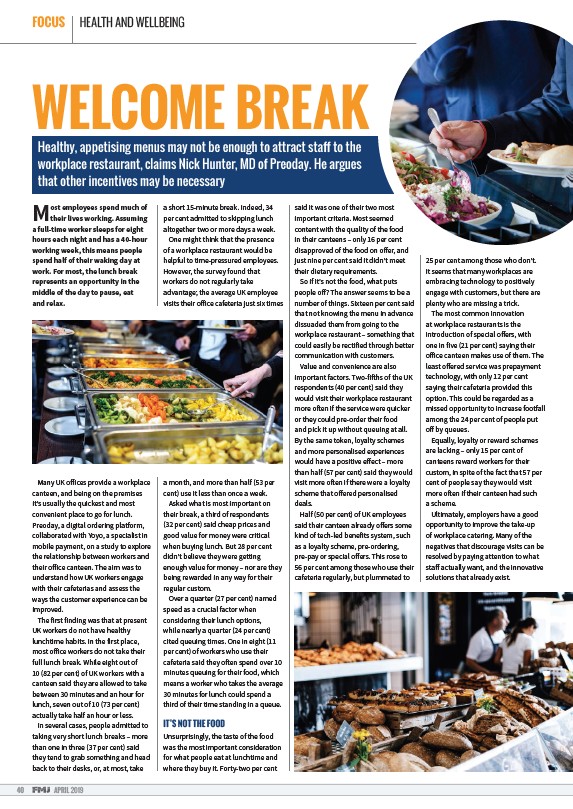
FOCUS HEALTH AND WELLBEING
WELCOME BREAK
Most employees spend much of
their lives working. Assuming
a full-time worker sleeps for eight
hours each night and has a 40-hour
working week, this means people
spend half of their waking day at
work. For most, the lunch break
represents an opportunity in the
middle of the day to pause, eat
and relax.
Many UK o ices provide a workplace
canteen, and being on the premises
it’s usually the quickest and most
convenient place to go for lunch.
Preoday, a digital ordering platform,
collaborated with Yoyo, a specialist in
mobile payment, on a study to explore
the relationship between workers and
their o ice canteen. The aim was to
understand how UK workers engage
with their cafeterias and assess the
ways the customer experience can be
improved.
The first finding was that at present
UK workers do not have healthy
lunchtime habits. In the first place,
most o ice workers do not take their
full lunch break. While eight out of
10 (82 per cent) of UK workers with a
canteen said they are allowed to take
between 30 minutes and an hour for
lunch, seven out of 10 (73 per cent)
actually take half an hour or less.
In several cases, people admitted to
taking very short lunch breaks – more
than one in three (37 per cent) said
they tend to grab something and head
back to their desks, or, at most, take
40 APRIL 2019
a short 15-minute break. Indeed, 34
per cent admitted to skipping lunch
altogether two or more days a week.
One might think that the presence
of a workplace restaurant would be
helpful to time-pressured employees.
However, the survey found that
workers do not regularly take
advantage; the average UK employee
visits their o ice cafeteria just six times
a month, and more than half (53 per
cent) use it less than once a week.
Asked what is most important on
their break, a third of respondents
(32 per cent) said cheap prices and
good value for money were critical
when buying lunch. But 28 per cent
didn’t believe they were getting
enough value for money – nor are they
being rewarded in any way for their
regular custom.
Over a quarter (27 per cent) named
speed as a crucial factor when
considering their lunch options,
while nearly a quarter (24 per cent)
cited queuing times. One in eight (11
per cent) of workers who use their
cafeteria said they o¡ en spend over 10
minutes queuing for their food, which
means a worker who takes the average
30 minutes for lunch could spend a
third of their time standing in a queue.
IT’S NOT THE FOOD
Unsurprisingly, the taste of the food
was the most important consideration
for what people eat at lunchtime and
where they buy it. Forty-two per cent
said it was one of their two most
important criteria. Most seemed
content with the quality of the food
in their canteens – only 16 per cent
disapproved of the food on o er, and
just nine per cent said it didn’t meet
their dietary requirements.
So if it’s not the food, what puts
people o ? The answer seems to be a
number of things. Sixteen per cent said
that not knowing the menu in advance
dissuaded them from going to the
workplace restaurant – something that
could easily be rectified through better
communication with customers.
Value and convenience are also
important factors. Two-fi¡ hs of the UK
respondents (40 per cent) said they
would visit their workplace restaurant
more o¡ en if the service were quicker
or they could pre-order their food
and pick it up without queuing at all.
By the same token, loyalty schemes
and more personalised experiences
would have a positive e ect – more
than half (57 per cent) said they would
visit more o¡ en if there were a loyalty
scheme that o ered personalised
deals.
Half (50 per cent) of UK employees
said their canteen already o ers some
kind of tech-led benefits system, such
as a loyalty scheme, pre-ordering,
pre-pay or special o ers. This rose to
56 per cent among those who use their
cafeteria regularly, but plummeted to
25 per cent among those who don’t.
It seems that many workplaces are
embracing technology to positively
engage with customers, but there are
plenty who are missing a trick.
The most common innovation
at workplace restaurants is the
introduction of special o ers, with
one in five (21 per cent) saying their
o ice canteen makes use of them. The
least o ered service was prepayment
technology, with only 12 per cent
saying their cafeteria provided this
option. This could be regarded as a
missed opportunity to increase footfall
among the 24 per cent of people put
o by queues.
Equally, loyalty or reward schemes
are lacking – only 15 per cent of
canteens reward workers for their
custom, in spite of the fact that 57 per
cent of people say they would visit
more o¡ en if their canteen had such
a scheme.
Ultimately, employers have a good
opportunity to improve the take-up
of workplace catering. Many of the
negatives that discourage visits can be
resolved by paying attention to what
sta actually want, and the innovative
solutions that already exist.
Healthy, appetising menus may not be enough to attract staff to the
workplace restaurant, claims Nick Hunter, MD of Preoday. He argues
that other incentives may be necessary